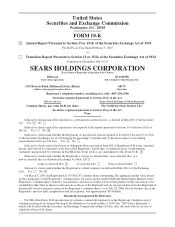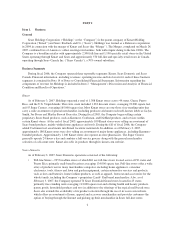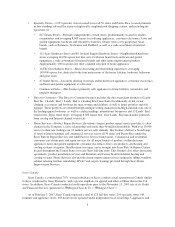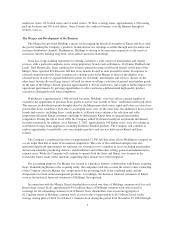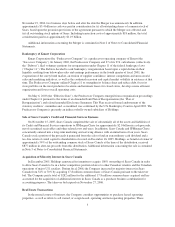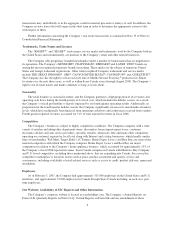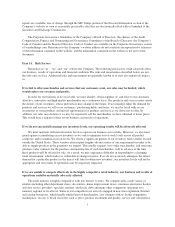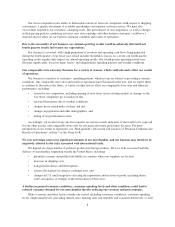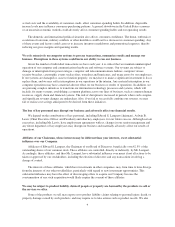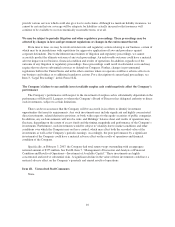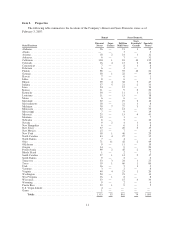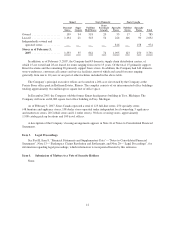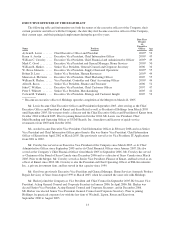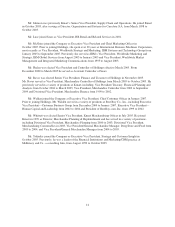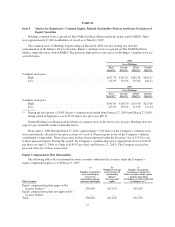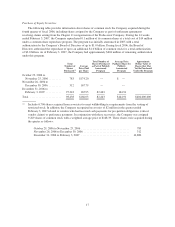Sears 2006 Annual Report Download - page 7
Download and view the complete annual report
Please find page 7 of the 2006 Sears annual report below. You can navigate through the pages in the report by either clicking on the pages listed below, or by using the keyword search tool below to find specific information within the annual report.reports are available, free of charge, through the SEC filings portion of the Investor Information section of the
Company’s website as soon as reasonably practicable after they are electronically filed with or furnished to the
Securities and Exchange Commission.
The Corporate Governance Guidelines of the Company’s Board of Directors, the charters of the Audit,
Compensation, Finance and Nominating and Governance Committees of the Board of Directors, the Company’s
Code of Conduct and the Board of Directors Code of Conduct are available on the Corporate Governance section
of searsholdings.com. References to the Company’s website address do not constitute incorporation by reference
of the information contained on the website, and the information contained on the website is not part of this
document.
Item 1A. Risk Factors
References to “us”, “we” and “our” refer to the Company. The following risk factors could adversely affect
our business, results of operations and financial condition. The risks and uncertainties described below are not
the only ones we face. Additional risks and uncertainties not presently known to us may also negatively impact
us.
If we fail to offer merchandise and services that our customers want, our sales may be limited, which
would reduce our revenues and profits.
In order for our business to be successful, we must identify, obtain supplies of, and offer to our customers
attractive, innovative and high-quality merchandise on a continuous basis. Our products and services must satisfy
the desires of our customers, whose preferences may change in the future. If we misjudge either the demand for
products and services we sell or our customers’ purchasing habits and tastes, we may be faced with excess
inventories of some products and missed opportunities for products and services we chose not to offer. In
addition, our sales may decline or we may be required to sell the merchandise we have obtained at lower prices.
This would have a negative effect on our business and results of operations.
If we do not successfully manage our inventory levels, our operating results will be adversely affected.
We must maintain sufficient inventory levels to operate our business successfully. However, we also must
guard against accumulating excess inventory as we seek to minimize out-of-stock levels across all product
categories and to maintain in-stock levels. We obtain a significant portion of our inventory from vendors located
outside the United States. These vendors often require lengthy advance notice of our requirements in order to be
able to supply products in the quantities we request. This usually requires us to order merchandise, and enter into
purchase order contracts for the purchase and manufacture of such merchandise, well in advance of the time
these products will be offered for sale. As a result, we may experience difficulty in responding to a changing
retail environment, which makes us vulnerable to changes in price. If we do not accurately anticipate the future
demand for a particular product or the time it will take to obtain new inventory, our inventory levels will not be
appropriate and our results of operations may be negatively impacted.
If we are unable to compete effectively in the highly competitive retail industry, our business and results of
operations could be materially adversely affected.
The retail industry is highly competitive with few barriers to entry. We compete with a wide variety of
retailers including other department stores, discounters, home improvement stores, consumer electronics dealers
and auto service providers, specialty retailers, wholesale clubs and many other competitors operating on a
national, regional or local level. Some of our competitors are actively engaged in new store expansion. Internet
and catalog businesses, which handle similar lines of merchandise, also compete with us. In this competitive
marketplace, success is based on factors such as price, product assortment and quality, service and convenience.
7

